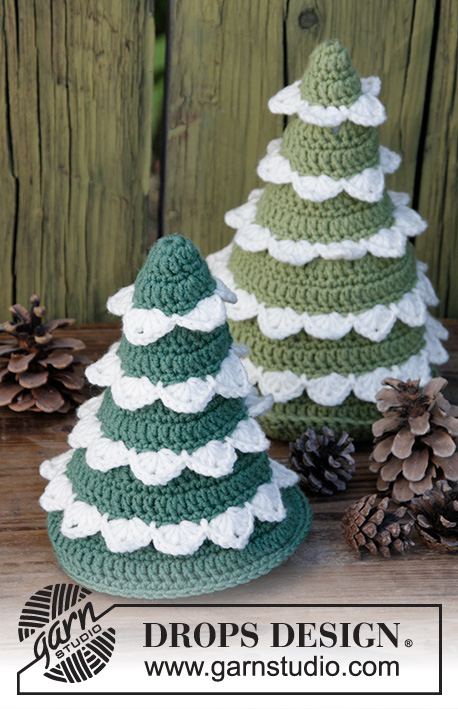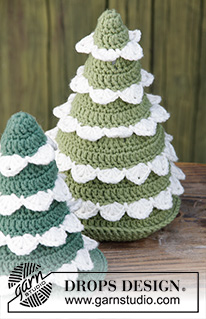Comments / Questions (19)
![]() Barucci wrote:
Barucci wrote:
Bonjour j\'ai commencé à réaliser ce tuto gratuit ,et merci de proposer des modèles gratuits. Malheureusement sur celui-ci, au rg 17 et 19 il a des erreurs. Cordialement
04.12.2024 - 08:19DROPS Design answered:
Bonjour Mme Barucci, je ne vois pas d'erreurs à ces 2 rangs. Au tour 17, on va crocheter alternativement (4 brides dans un arceau et 5 brides dans l'arceau suivant) et répéter de (à) 5 fois tout le tour (soit 5 fois 9 = 45 brides), de même au tour 19, vous crochetez (14 mailles serrées, 1 augmentation = 2 mailles serrées) 15 fois, soit (15x3= 45 mailles du tour 18 et 16x 3= 48 m à la fin du tour 19). Bon crochet!
18.12.2024 - 10:07
![]() Trees Van Aaken wrote:
Trees Van Aaken wrote:
Sorry. Ik lees nu de oplossing hieronder in de vertaling. Opgelost!
13.06.2024 - 21:32DROPS Design answered:
Dag Trees,
Dankjewel voor de terugkoppeling en veel handwerkplezier!
14.06.2024 - 20:13
![]() Trees Van Aaken wrote:
Trees Van Aaken wrote:
Na toer 16 heb je 10 lossenlussen. Als je daar eerst 4 en daarna 5 stokjes inhaakt kom ik uit op 50 stokjes ipv 45. Hoe kan dat
13.06.2024 - 21:23
![]() Catherine Trahot wrote:
Catherine Trahot wrote:
Bonjour, à la fin du rang 16, il y 10 arceaux. Si au rang 17, vous faites 4 br autour du 1er arceau puis 5 br dans chacun des 9 autres, cela fait un total de 4 + (9x5) = 4 + 45 = 49 br. et non 45 ! Tout le reste des explications est faux avec être erreur de 45/49 br.
09.12.2023 - 12:38DROPS Design answered:
Bonjour Mme Trahot, en fait, on ne va pas crocheter 5 brides autour de chaque arceau mais alternativement (4 brides dans un arceau et 5 brides dans l'arceau suivant) et répéter de (à) 5 fois tout le tour (soit 5 fois 9 = 45 brides). Bon crochet!
11.12.2023 - 09:57
![]() Kristina wrote:
Kristina wrote:
Jättebra mönster! Jag gjorde granen helt i grönt med stjärna på toppen. Passar att ställa med små tomtar och sånt.
03.11.2023 - 14:53
![]() Åsa Glanander wrote:
Åsa Glanander wrote:
Hej! Ska det vara ”hål” under snön?? Där luftmaskbågarna gjordes. Åsa
13.12.2021 - 18:08DROPS Design answered:
Hei Åsa. Ja, det blir et hull under snøen. Ta en titt på hjelpevideoen til dette juletreet så ser du det bedre. Hur virkas julgranen i DROPS Extra 0-1398 mvh DROPS Design
14.12.2021 - 11:49
![]() Joan Nelson wrote:
Joan Nelson wrote:
Where is the crochet pattern for the smaller tree?
16.04.2021 - 23:24DROPS Design answered:
Dear Joan, you can find how to make the small tree on the bottom of the pattern. Happy Crafting!
17.04.2021 - 00:42
![]() Zofia wrote:
Zofia wrote:
Thanks, that's The best and the easiest tutorial that I found. Thanks you really much
18.11.2020 - 14:03
![]() Nina Olaisen Grønning wrote:
Nina Olaisen Grønning wrote:
Er det noen som kan ta en titt på omg 16,17. det blir 4staver for mye på omg 17
17.10.2020 - 09:56DROPS Design answered:
Hei Nina. På 16. omgang har du 10 luftmaskebuer og på 17. omgang hekler du 4 staver i 1.,3., 5., 7. og 9. luftmaskebue = 20 staver. I 2., 4., 6., 8. og 10. luftmaskebue hekler du 5 staver = 25 staver. 20+25 staver = 45 staver. God Fornøyelse!
19.10.2020 - 21:00
![]() Marsha Kraft wrote:
Marsha Kraft wrote:
I agree with Kim Monsen. Round 17 has 49 stitches. Round 18 has 49 stitches . How do we fix this? If there wasn’t 4 double crochets, the count would be 45 stitches.
22.11.2019 - 18:49
The Christmas Forest#dropsthechristmasforest |
|
 |
 |
Crocheted Christmas tree. The piece is worked in DROPS Merino Extra Fine.
DROPS Extra 0-1398 |
|
|
INFORMATION FOR THE PATTERN: CROCHET INFO: The first single crochet on round is replaced by 1 chain stitch. Finish round with 1 slip stitch in first chain stitch. The first double crochet on round is replaced by 3 chain stitches. Finish round with 1 slip stitch in 3rd chain stitch. ---------------------------------------------------------- LARGE TREE: The tree is worked top down. Work the bottom of the tree, then snow around it. To finish, fill the tree with stuffing and the bottom is crocheted onto tree. Work 4 chain stitches with hook size 3.5 mm/E/4 and green and form them to a ring with 1 slip stitch in first chain stitch. ROUND 1: Work 8 single crochets around ring – read CROCHET INFO. ROUND 2: * 1 double crochet in first single crochet, 2 double crochets in next single crochet *, work from *-* to end of round = 12 double crochets. ROUND 3: * 1 single crochet in each of the 2 next double crochets, 2 single crochets in next double crochet *, work from *-* to end of round = 16 single crochets. ROUND 4: * 1 double crochet in each of the 3 first single crochets, 2 double crochets in next single crochet *, work from *-* to end of round = 20 double crochets. ROUND 5: Work 1 single crochet in each double crochet = 20 single crochets. ROUND 6: * Work 4 chain stitches, skip 3 single crochets, work 1 slip stitch in back loop of next single crochet *, work from *-* to end of round = 5 chain-spaces. ROUND 7: Work slip stitches to first space, work 4 double crochets around first space, then work 5 double crochets around the next 4 spaces = 24 double crochets. ROUND 8: Work 1 single crochet in each double crochet = 24 single crochets. ROUND 9: * 1 double crochet in each of the 5 first single crochets, 2 double crochets in next single crochet *, work from *-* to end of round = 28 double crochets. ROUND 10: Work 1 single crochet in each double crochet = 28 single crochets. ROUND 11: * Work 4 chain stitches, skip 3 single crochets, work 1 slip stitch in back loop of next single crochet *, work from *-* to end of round = 7 chain-spaces. ROUND 12: Work slip stitches to first space, work 5 double crochets around first space, then work 5 double crochets around the next 6 spaces = 35 double crochets. ROUND 13: Work 1 single crochet in each double crochet = 35 single crochets. ROUND 14: * 1 double crochet in each of the 6 first single crochets, 2 double crochets in next single crochet *, work from *-* to end of round = 40 double crochets. ROUND 15: Work 1 single crochet in each double crochet = 40 single crochets. ROUND 16: * Work 4 chain stitches skip 3 single crochets, work 1 slip stitch in back loop of next single crochet * work from *-* to end of round = 10 chain-spaces. ROUND 17: Work slip stitches to first space, *work 4 double crochets around first space, then work 5 double crochets around next space *, work from *-* to end of round = 45 double crochets. ROUND 18: Work 1 single crochet in each double crochet = 45 single crochets. ROUND 19: * 1 double crochet in each of the 14 first single crochets, 2 double crochets in next single crochet *, work from *-* to end of round = 48 double crochet. ROUND 20: Work 1 single crochet in each double crochet = 48 single crochets. ROUND 21: *Work 4 chain stitches, skip 3 single crochets, work 1 slip stitch in back loop of next single crochet *, work from *-* to end of round = 12 chain-spaces. ROUND 22: Work slip stitches to first space, work 5 double crochets around first space, then work 5 double crochets around the next 11 spaces = 60 double crochets. ROUND 23: Work 1 single crochet in each double crochet = 60 single crochets. ROUND 24: Work 1 double crochet in each single crochet = 60 double crochets. ROUND 25: Work 1 single crochet in each double crochet = 60 single crochets. ROUND 26: * Work 4 chain stitches, skip 3 single crochets, work 1 slip stitch in back loop of next single crochet *, work from *-* to end of round = 15 chain-spaces. ROUND 27: Work slip stitches to first space, * work 5 double crochets around each of the 4 first spaces, work 4 double crochets around next space *, work from *-* to end of round = 72 double crochets. ROUND 28: Work 1 single crochet in each double crochet = 72 single crochets. ROUND 29: Work 1 double crochet in each single crochet = 72 double crochets. Cut and fasten strand. BOTTOM: Work 4 chain stitches with hook size 3.5 mm/E/4 and green and form them to a ring with 1 slip stitch in first chain stitch. ROUND 1: Work 12 single crochets around the ring – read CROCHET INFO. ROUND 2: Work 2 double crochets in each single crochet = 24 double crochets. ROUND 3: * 1 single crochet in first double crochet, 2 single crochets in next double crochet *, work from *-* to end of round = 36 single crochets. ROUND 4: * 1 double crochet in each of the 2 first single crochets, 2 double crochets in next single crochet*, work from *-* to end of round = 48 double crochets. ROUND 5: * 1 single crochet in each of the 7 first double crochets, 2 single crochets in next double crochet *, work from *-* to end of round = 54 single crochets. ROUND 6: * 1 double crochet in each of the 8 first single crochets, 2 double crochets in next single crochet*, work from *-* to end of round = 60 double crochets. ROUND 7: * 1 single crochet in each of the 4 first double crochets, 2 single crochets in next double crochet *, work from *-* to end of round = 72 single crochets. Cut and fasten strand. SNOW: The snow is worked in the last round of single crochets before spaces on the tree (rounds 5, 10, 15, 20 and 25). Work with off white and hook size 3.5 mm/E/4 as follows: Work 1 slip stitch in first single crochet, * skip 1 single crochet, work 3 double crochets, 3 chain stitches, 3 double crochets in next single crochet, skip 1 single crochet, work 1 slip stitch in next single crochet *, work from *-* to end of round and finish with 1 slip stitch in first slip stitch on round. Cut and fasten strand. Fill the tree with stuffing and lay bottom towards the tree. Crochet together with 1 single crochet through one stitch from both layers. Cut and fasten strand. SMALL TREE: Work as large tree, but in forest green. Finish after round 24 on tree and round 6 on bottom. Work snow in rounds 5, 10, 15 and 20 on tree. Cut and fasten strands. |
|
Have you finished this pattern?Tag your pictures with #dropspattern #dropsthechristmasforest or submit them to the #dropsfan gallery. Do you need help with this pattern?You'll find 11 tutorial videos, a Comments/Questions area and more by visiting the pattern on garnstudio.com. © 1982-2025 DROPS Design A/S. We reserve all rights. This document, including all its sub-sections, has copyrights. Read more about what you can do with our patterns at the bottom of each pattern on our site. |
|
















































Post a comment to pattern DROPS Extra 0-1398
We would love to hear what you have to say about this pattern!
If you want to leave a question, please make sure you select the correct category in the form below, to speed up the answering process. Required fields are marked *.